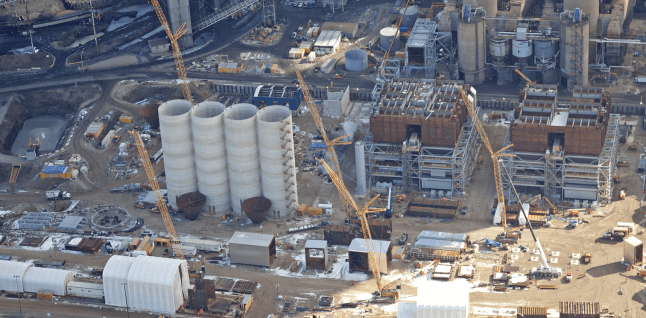US coal plants are preparing to comply with new EPA rules
The Homer City Generating Station in Indiana County, Pennsylvania is installing pollution controls that will reduce dangerous emissions of sulfur dioxide and mercury by more than 90 percent.
Around the country, coal-fired power plants are racing to comply with new EPA rules to keep sulfur dioxide and mercury out of the air.
The Homer City Generating Station is one such facility. It rises like a cathedral out of a valley in Indiana County, an hour east of Pittsburgh, Pennsylvania. You can see its smokestacks and hourglass shaped cooling towers from miles around.
The construction project to install new pollution controls at Homer City is a huge and expensive project. Total cost is estimated at $750 million. What makes the project so costly?
Construction manager Todd Kollross points to metal air ducts that will handle the exhaust for the new scrubber system. They’re much like the ductwork that carries air in your house, but they differ in one significant way: these air ducts are so big your house actually could fit inside them.
“That guy down there weighs about 325,000 pounds,” pointing to one of the ducts. “That one there weighs about 310,000 pounds.”
These ducts will handle airflow out of the plant’s boilers, which burn coal to create electricity. The boilers are big, too — the size of small office buildings.
“Take your furnace and put it on steroids,” Kollross says. “You're trying to heat your house; we’re trying to take care of two million homes.”
Two million homes — that’s how many buildings Homer City can power when it’s running at full capacity. Electricity streams out of the plant north to New York and into the mid-Atlantic grid that powers Pittsburgh, Philadelphia and Chicago.
The new equipment is needed because of clean air rules the Obama administration imposed on the coal industry. These include the Cross-State Air Pollution Rule and the Mercury and Air Toxics Standards.
Though the Supreme Court sent the Mercury rule back to the EPA, it’s still the law of the land. And it’s one reason why 200 old coal plants have decided to close.
James Shapiro, a vice president at GE Energy Financial Services, which owns the Homer City plant, says the company faced a tough decision when the rules were first announced. “You didn't have much choice,” he says. “Basically you either put on the pollution controls or you stopped running.”
So what does it take to keep 100,000 tons of pollution out of the air? Quite a lot.
Sulfur is one of the main pollutants in coal plant exhaust, so the plant has to install a scrubber system called Alstom Novel Integrated Desulfurization technology. Each scrubber unit consists of thousands of air filters.
Todd Kollross points out a room with hundreds of holes in the floor. Long tubes covered with fabric bags will be inserted into each hole. The bags are basically super-sized shop-vac filters.
The way it works is simple high school chemistry: the coal exhaust is acidic, so the plant will spray it with an alkaline powder. The powder will absorb the pollution and particulates in the exhaust and the filters catch the powder.
“There are about 40,000 bags between the two units,” Kollross explains. “All the particulate that we collect from the flue gas comes into these bags.”
The pollution then goes into a landfill, instead of into our lungs. All told, more than 90 percent of the pollution that would have gone into the air will get taken out of the plant’s smokestacks.
Kollross is pleased with his project. “The timetable on this thing was really tight and the teamwork was incredible,” he says. “I had my doubts we were going to make our deadline when we started this project, but it surpassed any expectations and it was quite a joy to work on. Best project I’ve ever worked on.”
The plant is on schedule to meet its final April 2016 deadline.
There’s one small problem though: Those new filters don’t remove carbon dioxide, the main culprit in global warming. And the EPA plans to limit carbon dioxide emissions from coal plants, too. So just in case, Homer City is applying for permission to switch the plant from coal to natural gas.
But even that may not be the final step. As recent studies have shown, methane leaks that occur throughout the natural gas process are much more widespread than previously thought. And methane is a greenhouse gas 25 times more powerful than CO2.
If the US is going to meet its obligations to reduce carbon emissions and other pollutants, many more massive projects will require the enthusiasm and expertise of Todd Kollross and others like him.
This article is based on a story by Reid Frazier of The Allegheny Front. The story aired on PRI’s Living on Earth with Steve Curwood.
